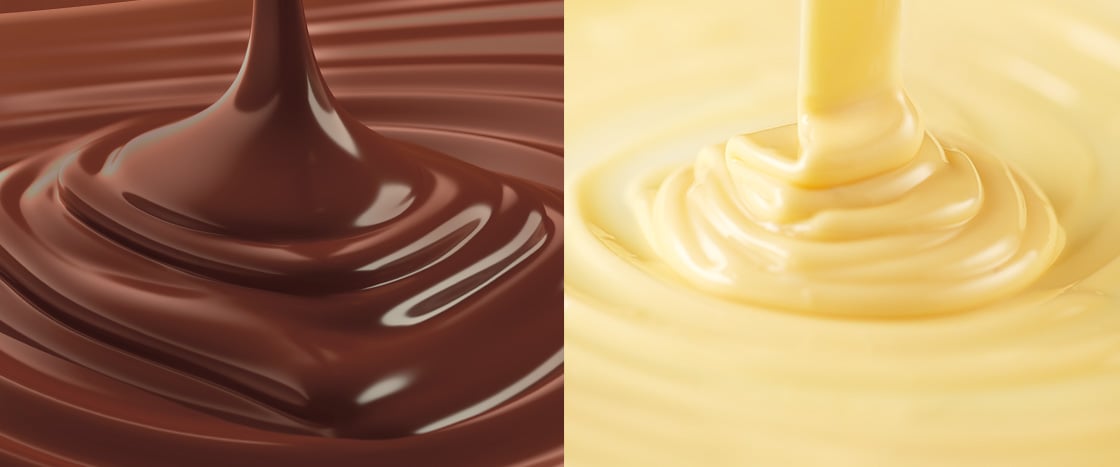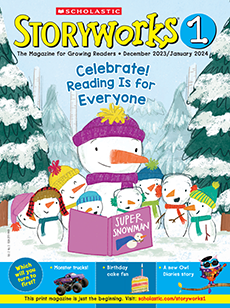It comes from a tree. Brown fruits grow on cacao (kuh-KOW) trees. Chocolate is made from the seeds in these fruits.

The Truth Behind Chocolate and Vanilla
Where do we get these two yummy flavors? The truth may surprise you. They come from plants!
Standards
Rich, Tasty Chocolate
BSIP/UNIVERSAL IMAGES GROUP VIA GETTY IMAGES
Where does it come from?
How is it made?
SHUTTERSTOCK.COM
an open cacao fruit
People pick the fruits and scoop out the seeds. They let the seeds dry and then crush them. But the seeds are not yummy yet.
Chocolate Treats
SHUTTERSTOCK.COM
Time to make chocolate. People melt the crushed seeds and mix them with sweet things. They can add sugar, milk, or vanilla. So yummy!
Sweet, Creamy Vanilla
MARTIN GABRIEL/NPL/MINDEN PICTURES
Where does it come from?
It comes from a plant. Long, green fruits grow on vanilla plants. Vanilla comes from these fruits.
How is it made?
ISTOCKPHOTO/GETTY IMAGES
dried vanilla fruits
People pick the fruits and dip them in hot water. The fruits turn dark brown as they dry. Later it is time to scoop out the insides.
Vanilla treats
SHUTTERSTOCK.COM
People use the insides in sweet goodies. They put vanilla in pudding, cookies, and ice cream. Which is your favorite?
More About the Article
English Language Arts Focus
Comparing
Science Focus
Characteristics of plants
Engineering and technology
Vocabulary
flavors, fruits, seeds
Essential Question
The essential question of this issue is What can we learn from the foods we eat? The articles below connect to this theme.
- Silly Story: Fun Phonics: “A Cake for Jake,” p. 4
- Word Play: Vocabulary: “Ways to Say Yummy,” p. 19
- Paired Texts: “The Truth Behind Chocolate and Vanilla,” p. 20
- Fiction: Folktale: “The Little Round Bun,” p. 24
- Poetry Kit: “A Lot Dog,” p. 32
Through the above genres, students will discuss:
- What foods do you like to eat?
- Where do different foods come from?
- What stories do we tell about foods?
IMPLEMENTATION SUGGESTIONS
Read-Aloud
- Storyworks 1 provides a variety of text types and levels that you can use in different ways. One suggestion is to read “The Truth Behind Chocolate and Vanilla” during a whole-class read-aloud. Use the articles’ parallel structures to discuss similarities and differences between the texts.
Small Group
- Focus on comparison as a higher-order comprehension skill in a small group lesson. Read the text to provide modeling and scaffolding as students make comparisons. Then ask students to complete our comparison skills pages.
1. BEFORE READING
Show a Video (10 minutes)
- Tell children that they are going to watch a video about the foods we eat. (This video also goes with other stories in the issue).
Set a Purpose for Reading and Preview the Article (7-10 minutes)
- Now tell students they are going to read about yummy chocolate and tasty vanilla. They might be surprised to find out where these delicious flavors come from.
- Preview the bolded words in the article. Play the online vocabulary slideshow. This article’s featured words are flavors, fruits, and seeds. Be sure to turn the sound on!
- Open your magazines to the article. Have children look at the photos and brainstorm what they already know about chocolate and vanilla. Then read the headline and the opening text. Did students know these flavors both come from plants?
2. READ THE PAIRED TEXTS (15-30 MINUTES)
- Remind children that they will compare chocolate and vanilla. They will find out how each of these yummy treats are made.
- Starting with the first category (Where Does It Come From?), discuss how they differ.
- Compare the chocolate and vanilla photos. What information can you learn by looking at the photos.
- To finish, ask students to turn and talk to a partner to recall some ways chocolate and vanilla are the same. Have volunteers share their answers. Then ask ways chocolate and vanilla are different.
3. AFTER READING: FOCUS ON SKILLS
ELA Focus: Compare and Contrast (20 minutes)
- With the Chocolate or Vanilla? skills page, children can use a Venn diagram to compare chocolate and vanilla.
ELA Focus: Compare and Contrast (15 minutes)
- The Which Flavor? skills page provides additional support for making comparisons.
